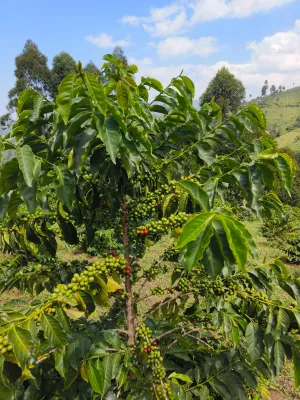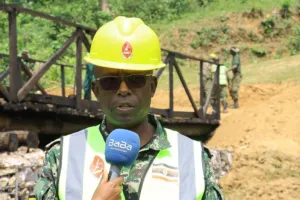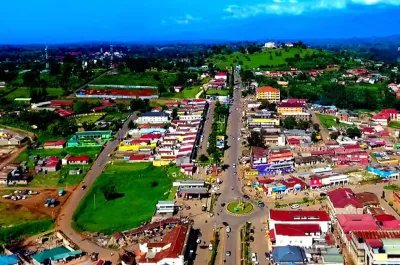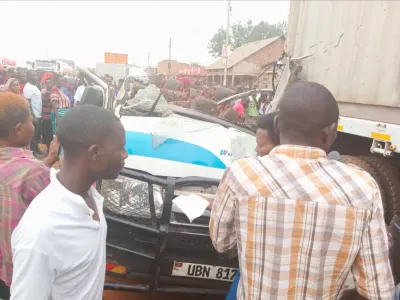
Mr. President, at Kapeeka in Luwero. The lecture I was requested to deliver, “The Potential of Rural and Agricultural Industrialization to Develop Uganda” has been given to other local government leaders before. Last year, I gave the same lecture to LC 3 Chairpersons from Buganda again in Kapeeka. I also gave the same lecture to all LC 5 Chairpersons, under their umbrella organisation, the Uganda Local Governments’ Association (ULGA), at their annual meeting that was held in Jinja.
Why Kapeeka? What is so special about Kapeeka to attract leaders on several occasions? Something special is silently going on in Kapeeka, about 60km from Kampala city. A laboratory to put to test some of the ideas I was sharing with our local leaders was set up there by Gen. Salim Saleh.
I first met Gen. Saleh in July 2009. A student of mine, whom I taught Ugandan Economy, among other subjects in economics, had tipped Saleh about my ideas on Uganda’s economy. Saleh invited me to his home in Garuga, Entebbe, for a chat. He said, “Mwalimu, they told me you have some ideas that may get me out of this confusion.” Before even asking him to elaborate the “confusion” he was enduring, Saleh asked, “Why have our people failed to develop agriculture, yet so many efforts have been put in to advance the sector?”
Instead of giving him an answer, I asked the four-star General to tell me, first, what he thought was the reason. He promised to put his answer on paper such that I can guide him well. We resorted to talking about other economics and off I left without giving my opinion on the question he had posed.
A month or so later, the General sent me a mail with a three page attachment and a request, “Please Mwalimu, mark my work.” I read through and sent it back to him with a grade, “B–”. The General invited me again to compare notes. Although he was this time more interested in why I gave him a B– yet some people thought he qualified for an A or A+, I opted to instead give him a thorough analysis of what I thought, and still think, is Uganda’s main problem.
Low productivity
This is the same lecture I have been asked to give to several other leaders. It is the same idea that eventually concretized the Namunkekera Rural Industrial Centre (NRIC) — the magnet that attracts leaders to Kapeeka.
Mr. President, I wanted to share with you this idea. Here we go: Uganda has about 199,810 sq. km of land. At independence, in 1962, we were using 45% (3.2m hectares or about 7.9m acres) of this land for agriculture. We have since opened up more land up to 71% or 6.9m hectares or about 17 million acres.
We are now 35 million people; housed in 7.3 million households. This implies that on average every household (or family) now has about 2.5 acres of land. On this land, we build a house and a compound or several of them since many Ugandans are polygamous, we reserve space for burial (graveyard), and remain with about 1.5 acres for farming. In effect, therefore, we can only remain smallholder farmers. There is simply no land for large-scale mechanized farming in the larger part of the country, except parts of Northern, Karamoja and Western Uganda.
With the growing population, increasing at an annual rate of 3%, in the future, agricultural output will only be increased through increased productivity but not acreage.
Statistics further indicate that currently, agriculture employs about 73% of Ugandans, but it contributes 20% to Uganda’s GDP. These statistics have the following implications:
Firstly, the statistics show that productivity by the agricultural sector (i.e. the ratio of the output to the acreage used and/or number of people engaged) is very low. Take the example of coffee, Uganda’s historic major export crop. Ugandans use nearly 6 acres of land to produce a single tonne of coffee. Other producers of coffee, such as Brazil and Vietnam, on average harvest a tonne every 2 acres.
Why past efforts failed
Uganda’s problem is compounded by unacceptably high post-harvest losses. On average we lose nearly half of our harvest to insects, floods, rodents, and other causes.
Therefore, ours is a double tragedy: low productivity and high levels of post-harvest losses. However, research has shown that losses increase with time. For example, although farmers lose only 21% of their maize in the first 30 days after harvest, the losses increase to 60% after 90 days.
This implies that the first step to reduce the losses is quick evacuation of produce from famers. What does this require? A ready market or more practically, processing of the produce right in the villages.
The second, implication of having low contribution by agriculture to GDP yet the sector employs many people, is subsistence farming. We still producing to eat, grow up and die. Then pass over the land to our children to extend the tragedy.
The statistics also prove why household poverty is high. Three quarters of the population are stuck in a sector that is neither productive nor efficient. Thus, Uganda’s main economic challenge is 3 fold: (1) how to raise agriculture productivity, reduce subsistence and increase household incomes; (2) how to speed up the movement of people out of agriculture into more productive sectors; and (3) how to facilitate structural transformation of the economy to create more productive and decent jobs for the young people we are educating.
Are we beginning on a blank slate? Not at all. Under NRM government alone, we’ve had several programs, plans, and visions to address the abovementioned challenges. PAPSCA (the Program for Alleviation of Poverty and the Social Costs of Adjustment) was the first major program launched in 1988 at a cost of $28m (or about Shs. 78 billion, financed by the World Bank.
Then PAP (Poverty Alleviation Project) was launched in 1993, costing African Development Bank about $10m (Shs. 28 billion). Entandikwa scheme quickly followed in 1994 at a cost of $6m (Shs. 16.8 billion) of Ugandan taxpayer’s money.
Concentrating on symptoms
When that failed we launched PEAP (Poverty Eradication Action Plan) in 1997 as policy framework to guide expenditure on poverty eradication. We created a PAF (Poverty Action Fund) in 1998, starting with an initial injection of $40m (Shs.112bn) to enable MPs develop their constituencies.
In 2001 we wrote and rolled out the PMA (Plan for Modernisation of Agriculture), where NAADs (National Agricultural Adversary Services) was a key pillar. By that time we had just written the Vision 2025 in 1999. When all these failed, we thought out some buzz words and Bonna Bagaggawale (Prosperity for All) sounded more romantic. In 2008, we decided to resort to central planning (the National Development Plan and Vision 2040 were penned).
Question: why did all these well-intentioned efforts fail? Someone looking for quick answers will point the accusing finger at the corruption or poor implementation of the programs, or low priority assigned to agriculture in the national budget. The list is long, and can go on and on.
However, the main reason for the failure of agriculture in Uganda is embedded in our historical mistake of promoting agriculture on the assumption that “production is the source of demand.” This is the mistake of relying on the ‘old economics’ of “Supply creates its own demand” (Say’s Law, by French Economist Jean-Baptist Say, 1767–1832). We have always assumed that we can convince farmers (through radios, political rallies, seminars etc.) to produce.
Indeed whenever peasants failed to produce enough or to sustain production, we baptized them lazy. This is the biggest, innocent mistake we have been doing since independence. We failed to diagnose the disease and concentrated on treating the symptoms.
What’s the disease? We need to adopt a new thinking: a reverse of Say’s Law. We need to start promoting agriculture on the theory that “Demand creates its own supply”. People cannot have the incentive to produce more if their harvest goes to waste or is bought at prices lower than they anticipated. Agriculture prices and output face a cobweb scenario: high prices today elicit more output next season, which then causes a drop in prices and discourages production the subsequent season…and so on.
Way forward
The idea I shared with Gen. Saleh was that government should put more effort on two areas: Small-and medium-scale agro-processing and bilateral markets. This is what Uganda needs to provide incentive to peasants to “die in the garden”. The two will stabilize demand and prices for agricultural produce.
Agro-processing plants, spread across the country, will help to add value to farmers’ produce, reduce waste, and hence reduce uncertainty in agriculture. Saleh’s NRIC has demonstrated in Kapeeka, that this model would quickly create forward and backward linkages to smallholder farmers’ activities.
For example, the NRIC adds value to maize (i.e. flour); the maize stalks and husks are crushed into animal feeds, while the cobs are used to make products such as charcoal (briquettes). In future other processes will manufacture more high-value products, such as cornflakes, starch (a main ingredient in plastics and confectioners), alcohol (whiskey and ethanol), margarine oil, glue etc.
Thus the model will create conditions for small farmers to thrive (stabilizes price, reduces post-harvest losses, and add value). Secondly, it will help get people out of agriculture into small-scale industry. The proceeds from agricultural surpluses will be used to build an export-oriented manufacturing base. Thirdly, it’s the basic way to help the economy to speed up the completion of agriculture revolution and provide a pebble for industrialization and the services sector.
It was Albert Einstein who said, “Any fool can make things bigger, more complex, and more violent. It takes a touch of genius—and a lot of courage—to move in the opposite direction.” I salute Gen. Saleh for accepting to take the risk and pilot this model. When he failed to convince government to finance the pilot, he sold his house where we met for the very first time to raise money to invest in our “simplistic idea”. If that’s not courage then courage has no meaning.














Ramathan Ggoobi
Ramathan Ggoobi is Policy Analyst, and Researcher. He lecturers economics at Makerere University Business School (MUBS) and has co-authored several studies on Uganda's economy. For the past ten years, he has published a weekly column 'Are You Listening Mr. President' in The Sunrise Newspaper, Uganda's Leading Weekly
Leave a Comment
Your email address will not be published.